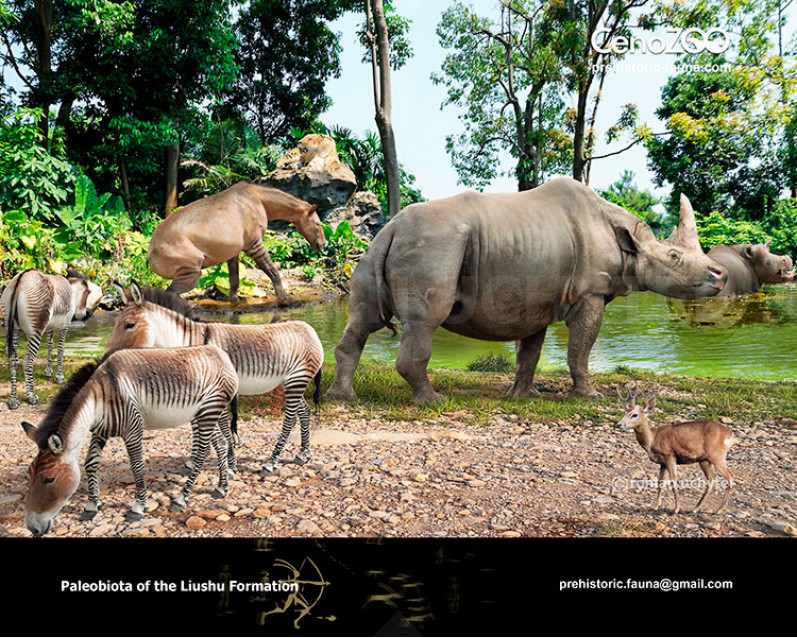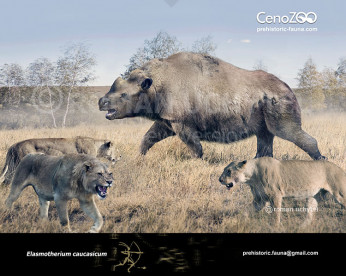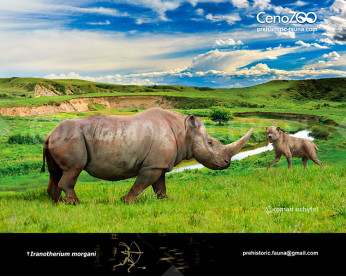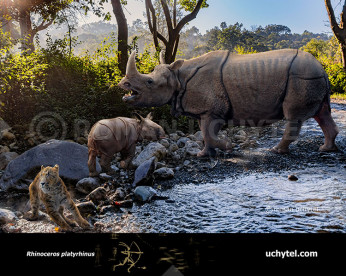Sinotherium
29982998
Sinotherium (†Sinotherium (Ringstrom, 1923))
Order: Perissodactyla
Family: Rhinocerotidae
Subfamily: †Elasmotheriinae
Size: 4 m in length, 180-230 cm in height, ~3500 kg of weight
Time period: the Late Miocene to Early Pliocene (Asia).
Typical representative: †Sinotherium lagrelii Ringstrom, 1923
Sinotherium is a single-horned elasmotheriine rhinoceros that lived from the late Miocene to Early Pliocene. Its fossils have been found in the Karabulak Formation of Kazakhstan, lower jaw and teeth have been found in Mongolia, and a partial skull is known from the upper part of the Liushu Formation of western China. It was ancestral to Elasmotherium, demonstrating a very important evolutionary transition from nasal-horned elasmotheriines to frontal-horned elasmotheriines. Sinotherium diverged from the ancestral genus, Iranotherium, first found in Iran, during the early Pliocene. Some experts prefer to lump Sinotherium, and Iranotherium into Elasmotherium.
A transition between state of nose-horned to forehead-horned elasmotheriines remained missing until 2012, when the first cranial remains of Sinotherium lagrelii, (a partial skull housed at the Institute of Vertebrate Paleontology and Paleoanthropology, Chinese Academy of Sciences in Beijing) was described, demonstrating a very important transition from nose-horned elasmotheriines like Ningxiatherium to forehead-horned elasmotheriines like Elasmotherium.
While the horns of Ningxiatherium-like elasmotheriines are present on their nasals, and the horn of Elasmotherium on its frontals, Sinotherium shows a unique condition in which its horn is present in an intermediate "naso-frontal" position and also preserves a rugosity on its forehead, which implies that the animal had two horns. This shows the horn shifting from its ancestral nasal position to a more derived frontal position, eventually resulting in the completely frontal restricted position of Elasmotherium.
In China, the species S. lagrelii is known from an age of 7 Ma from the red clays of the Late Miocene Liushu Formation in the Linxia Basin, Gansu Province.
Оплата
У Вас є кілька зручних способів купівлі зображення: кредитна чи дебетова картка Visa, Mastercard, Maestro; PayPal або банківський переказ
Sinotherium (†Sinotherium (Ringstrom, 1923))
Order: Perissodactyla
Family: Rhinocerotidae
Subfamily: †Elasmotheriinae
Size: 4 m in length, 180-230 cm in height, ~3500 kg of weight
Time period: the Late Miocene to Early Pliocene (Asia).
Typical representative: †Sinotherium lagrelii Ringstrom, 1923
Sinotherium is a single-horned elasmotheriine rhinoceros that lived from the late Miocene to Early Pliocene. Its fossils have been found in the Karabulak Formation of Kazakhstan, lower jaw and teeth have been found in Mongolia, and a partial skull is known from the upper part of the Liushu Formation of western China. It was ancestral to Elasmotherium, demonstrating a very important evolutionary transition from nasal-horned elasmotheriines to frontal-horned elasmotheriines. Sinotherium diverged from the ancestral genus, Iranotherium, first found in Iran, during the early Pliocene. Some experts prefer to lump Sinotherium, and Iranotherium into Elasmotherium.
A transition between state of nose-horned to forehead-horned elasmotheriines remained missing until 2012, when the first cranial remains of Sinotherium lagrelii, (a partial skull housed at the Institute of Vertebrate Paleontology and Paleoanthropology, Chinese Academy of Sciences in Beijing) was described, demonstrating a very important transition from nose-horned elasmotheriines like Ningxiatherium to forehead-horned elasmotheriines like Elasmotherium.
While the horns of Ningxiatherium-like elasmotheriines are present on their nasals, and the horn of Elasmotherium on its frontals, Sinotherium shows a unique condition in which its horn is present in an intermediate "naso-frontal" position and also preserves a rugosity on its forehead, which implies that the animal had two horns. This shows the horn shifting from its ancestral nasal position to a more derived frontal position, eventually resulting in the completely frontal restricted position of Elasmotherium.
In China, the species S. lagrelii is known from an age of 7 Ma from the red clays of the Late Miocene Liushu Formation in the Linxia Basin, Gansu Province.


1-797x638.jpg)
-797x638.jpg)

1-70x56.jpg)
-70x56.jpg)



